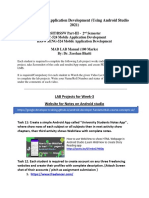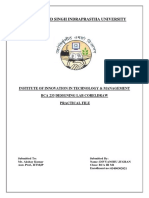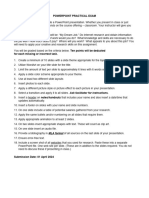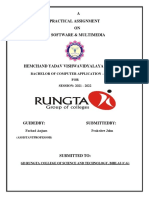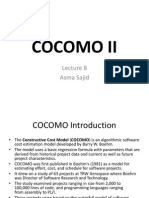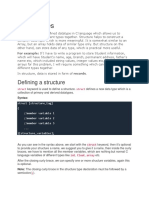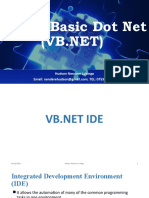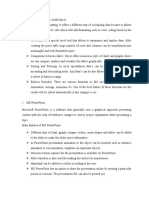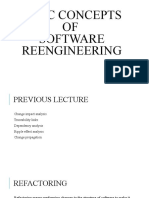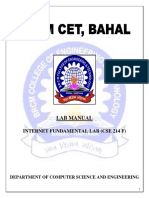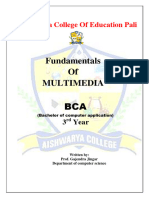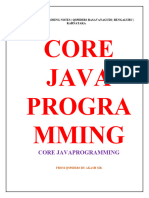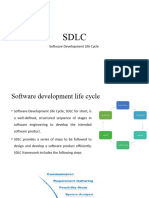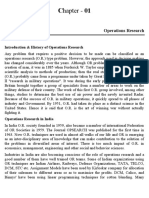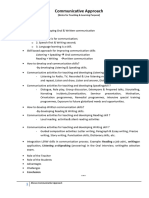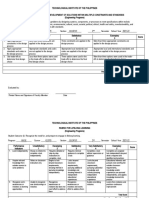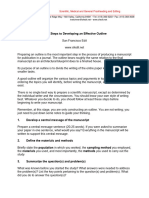2/13/24, 9:35 PM SDLC Models - javatpoint
Home Software Engineering Software Testing Operating System Java COA Computer Network
https://www.javatpoint.com/software-engineering-sdlc-models 1/10
�2/13/24, 9:35 PM SDLC Models - javatpoint
ADVERTISEMENT
SDLC Models
Software Development life cycle (SDLC) is a spiritual model used in project management that defines
the stages include in an information system development project, from an initial feasibility study to
the maintenance of the completed application.
There are different software development life cycle models specify and design, which are followed
during the software development phase. These models are also called "Software Development
Process Models." Each process model follows a series of phase unique to its type to ensure success
in the step of software development.
Here, are some important phases of SDLC life cycle:
https://www.javatpoint.com/software-engineering-sdlc-models 2/10
�2/13/24, 9:35 PM SDLC Models - javatpoint
Waterfall Model
The waterfall is a universally accepted SDLC model. In this method, the whole process of software
development is divided into various phases.
The waterfall model is a continuous software development model in which development is seen as
flowing steadily downwards (like a waterfall) through the steps of requirements analysis, design,
implementation, testing (validation), integration, and maintenance.
Linear ordering of activities has some significant consequences. First, to identify the end of a phase
and the beginning of the next, some certification techniques have to be employed at the end of each
step. Some verification and validation usually do this mean that will ensure that the output of the
stage is consistent with its input (which is the output of the previous step), and that the output of the
stage is consistent with the overall requirements of the system.
RAD Model
RAD or Rapid Application Development process is an adoption of the waterfall model; it targets
developing software in a short period. The RAD model is based on the concept that a better system
can be developed in lesser time by using focus groups to gather system requirements.
ADVERTISEMENT ADVERTISEMENT
https://www.javatpoint.com/software-engineering-sdlc-models 3/10
�2/13/24, 9:35 PM SDLC Models - javatpoint
Business Modeling
Data Modeling
Process Modeling
Application Generation
Testing and Turnover
Spiral Model
The spiral model is a risk-driven process model. This SDLC model helps the group to adopt
elements of one or more process models like a waterfall, incremental, waterfall, etc. The spiral
technique is a combination of rapid prototyping and concurrency in design and development
activities.
Each cycle in the spiral begins with the identification of objectives for that cycle, the different
alternatives that are possible for achieving the goals, and the constraints that exist. This is the first
quadrant of the cycle (upper-left quadrant).
The next step in the cycle is to evaluate these different alternatives based on the objectives and
constraints. The focus of evaluation in this step is based on the risk perception for the project.
https://www.javatpoint.com/software-engineering-sdlc-models 4/10
�2/13/24, 9:35 PM SDLC Models - javatpoint
The next step is to develop strategies that solve uncertainties and risks. This step may involve
activities such as benchmarking, simulation, and prototyping.
V-Model
In this type of SDLC model testing and the development, the step is planned in parallel. So, there are
verification phases on the side and the validation phase on the other side. V-Model joins by Coding
phase.
Incremental Model
The incremental model is not a separate model. It is necessarily a series of waterfall cycles. The
requirements are divided into groups at the start of the project. For each group, the SDLC model is
followed to develop software. The SDLC process is repeated, with each release adding more
functionality until all requirements are met. In this method, each cycle act as the maintenance phase
for the previous software release. Modification to the incremental model allows development cycles
to overlap. After that subsequent cycle may begin before the previous cycle is complete.
Agile Model
Agile methodology is a practice which promotes continues interaction of development and testing
during the SDLC process of any project. In the Agile method, the entire project is divided into small
incremental builds. All of these builds are provided in iterations, and each iteration lasts from one to
three weeks.
Any agile software phase is characterized in a manner that addresses several key assumptions about
the bulk of software projects:
1. It is difficult to think in advance which software requirements will persist and which will
change. It is equally difficult to predict how user priorities will change as the project proceeds.
2. For many types of software, design and development are interleaved. That is, both activities
should be performed in tandem so that design models are proven as they are created. It is
difficult to think about how much design is necessary before construction is used to test the
configuration.
3. Analysis, design, development, and testing are not as predictable (from a planning point of
view) as we might like.
https://www.javatpoint.com/software-engineering-sdlc-models 5/10
�2/13/24, 9:35 PM SDLC Models - javatpoint
Iterative Model
It is a particular implementation of a software development life cycle that focuses on an initial,
simplified implementation, which then progressively gains more complexity and a broader feature set
until the final system is complete. In short, iterative development is a way of breaking down the
software development of a large application into smaller pieces.
Big bang model
Big bang model is focusing on all types of resources in software development and coding, with no or
very little planning. The requirements are understood and implemented when they come.
This model works best for small projects with smaller size development team which are working
together. It is also useful for academic software development projects. It is an ideal model where
requirements are either unknown or final release date is not given.
Prototype Model
The prototyping model starts with the requirements gathering. The developer and the user meet and
define the purpose of the software, identify the needs, etc.
A 'quick design' is then created. This design focuses on those aspects of the software that will be
visible to the user. It then leads to the development of a prototype. The customer then checks the
prototype, and any modifications or changes that are needed are made to the prototype.
https://www.javatpoint.com/software-engineering-sdlc-models 6/10
�2/13/24, 9:35 PM SDLC Models - javatpoint
Looping takes place in this step, and better versions of the prototype are created. These are
continuously shown to the user so that any new changes can be updated in the prototype. This
process continue until the customer is satisfied with the system. Once a user is satisfied, the
prototype is converted to the actual system with all considerations for quality and security.
← Prev Next →
Youtube For Videos Join Our Youtube Channel: Join Now
Feedback
Send your Feedback to feedback@javatpoint.com
https://www.javatpoint.com/software-engineering-sdlc-models 7/10
�2/13/24, 9:35 PM SDLC Models - javatpoint
Help Others, Please Share
Learn Latest Tutorials
Splunk tutorial SPSS tutorial Swagger T-SQL tutorial
tutorial
Splunk SPSS Transact-SQL
Swagger
Tumblr tutorial React tutorial Regex tutorial Reinforcement
learning tutorial
Tumblr ReactJS Regex
Reinforcement
Learning
R Programming RxJS tutorial React Native Python Design
tutorial tutorial Patterns
RxJS
R Programming React Native Python Design
Patterns
Python Pillow Python Turtle Keras tutorial
tutorial tutorial
Keras
Python Pillow Python Turtle
Preparation
Aptitude Logical Verbal Ability Interview
Reasoning Questions
Aptitude Verbal Ability
Reasoning Interview Questions
https://www.javatpoint.com/software-engineering-sdlc-models 8/10
�2/13/24, 9:35 PM SDLC Models - javatpoint
Company
Interview
Questions
Company Questions
Trending Technologies
Artificial AWS Tutorial Selenium Cloud
Intelligence tutorial Computing
AWS
Artificial Selenium Cloud Computing
Intelligence
Hadoop tutorial ReactJS Data Science Angular 7
Tutorial Tutorial Tutorial
Hadoop
ReactJS Data Science Angular 7
Blockchain Git Tutorial Machine DevOps
Tutorial Learning Tutorial Tutorial
Git
Blockchain Machine Learning DevOps
B.Tech / MCA
DBMS tutorial Data Structures DAA tutorial Operating
tutorial System
DBMS DAA
Data Structures Operating System
Computer Compiler Computer Discrete
Network tutorial Design tutorial Organization and Mathematics
Architecture Tutorial
https://www.javatpoint.com/software-engineering-sdlc-models 9/10
�2/13/24, 9:35 PM SDLC Models - javatpoint
Computer Network Compiler Design Computer Discrete
Ethical Hacking Computer Software
Organization html tutorial
Mathematics
Graphics Tutorial Engineering
Ethical Hacking Web Technology
Computer Graphics Software
Engineering
Cyber Security Automata C Language C++ tutorial
tutorial Tutorial tutorial
C++
Cyber Security Automata C Programming
Java tutorial .Net Python tutorial List of
Framework Programs
Java Python
tutorial
Programs
.Net
Control Data Mining Data
Systems tutorial Tutorial Warehouse
Tutorial
Control System Data Mining
Data Warehouse
https://www.javatpoint.com/software-engineering-sdlc-models 10/10

